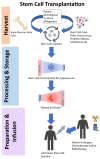The Role of Allogeneic Stem Cell Transplantation in Multiple Myeloma: A Systematic Review of the Literature
- PMID: 34725596
- PMCID: PMC8553292
- DOI: 10.7759/cureus.18334
The Role of Allogeneic Stem Cell Transplantation in Multiple Myeloma: A Systematic Review of the Literature
Abstract
Multiple myeloma (MM) is an indolent B-cell malignancy, where treatment is aimed at preventing organ dysfunction from light chain accumulation (slowing disease progression) and inducing remission. Allogeneic stem cell transplant (allo-SCT), through graft versus myeloma (GVM) effects, has the potential to induce remission to a potentially curative-like state. In this systematic review, we aimed to understand this relationship to the risks and severity of disease in categorized patients and gain an updated comprehension of the future of allo-SCT in MM treatment. We conducted this review according to the Preferred Reporting Items for Systematic Reviews and Meta-Analyses (PRISMA) guidelines and searched the PubMed database to obtain the specified literature with both the use of keywords and Medical Subject Headings (MeSH). A total of 16 relevant articles were included for discussion after the quality appraisal was completed, as appropriate, by either the Cochrane tool or Newcastle-Ottawa checklist. Our review concludes that while allo-SCT may benefit high-risk patients, successful procedures may incorporate a tandem autologous hematopoietic stem cell transplant approach in combination with novel pharmacologic contributions for which there is an observed synergy in the modulation of the immunologic microenvironment. Furthermore, tailored patient selection by evaluating pre-transplant factors including high-risk cytogenetics, age, and pre-salvage International Staging System (ISS) can predict post-transplantation success including non-relapse mortality. Successive research should continue to revise and update treatment options as the evolving therapeutic drug regimens may change over the course of indolent disease.
Keywords: allogeneic stem cell transplant recipients; allogenic bone marrow transplant; graft vs myeloma; multiple myeloma; stem cell transplant for hematological malignancies.
Copyright © 2021, Khorochkov et al.
Conflict of interest statement
The authors have declared that no competing interests exist.
Figures
Similar articles
-
Autologous followed by allogeneic versus tandem-autologous transplantation in high-risk, newly diagnosed multiple myeloma: a systematic review and meta-analysis.Hematology. 2023 Dec;28(1):2269509. doi: 10.1080/16078454.2023.2269509. Epub 2023 Oct 18. Hematology. 2023. PMID: 37850613
-
Allogeneic stem-cell transplantation for multiple myeloma: a systematic review and meta-analysis from 2007 to 2017.Cancer Cell Int. 2018 Apr 23;18:62. doi: 10.1186/s12935-018-0553-8. eCollection 2018. Cancer Cell Int. 2018. PMID: 29713245 Free PMC article.
-
Establishment of a murine graft-versus-myeloma model using allogeneic stem cell transplantation.PLoS One. 2014 Nov 21;9(11):e113764. doi: 10.1371/journal.pone.0113764. eCollection 2014. PLoS One. 2014. PMID: 25415267 Free PMC article.
-
Treatment of multiple myeloma.Haematologica. 1999 Jan;84(1):36-58. Haematologica. 1999. PMID: 10091392 Review.
-
Allogeneic Stem Cell Transplantation in Multiple Myeloma.Cancers (Basel). 2021 Dec 23;14(1):55. doi: 10.3390/cancers14010055. Cancers (Basel). 2021. PMID: 35008228 Free PMC article. Review.
Cited by
-
The Long-Acting Glucagon-Like Peptide-2 Analog Apraglutide Enhances Intestinal Protection and Survival After Chemotherapy and Allogeneic Transplantation in Mice.Ann Transplant. 2024 Nov 5;29:e945249. doi: 10.12659/AOT.945249. Ann Transplant. 2024. PMID: 39497378 Free PMC article.
References
Publication types
LinkOut - more resources
Full Text Sources


